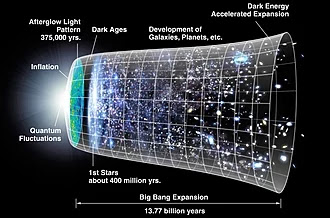Black Holes
 A Black Hole is a region in space where the gravitational effects are extremely strong. They are so strong that even light and electromagnetic radiations cannot escape from it. It is said that a Black Hole is formed at the end of a Star's Life. When a Star is dying all its matter is compressed and forms a small body whose mass is very high. Black Holes of the size of an atom can have a mass more than a mountain. The boundary of the Black Hole from where no object can escape, not even light is called as the Event Horizon. One can easily enter a Black Hole but there are no possible chances of coming out of it. The gravitational forces can easily rip apart the objects that enter a black hole in such a way that there will be no physical evidences of the existence of the object.
A Black Hole is a region in space where the gravitational effects are extremely strong. They are so strong that even light and electromagnetic radiations cannot escape from it. It is said that a Black Hole is formed at the end of a Star's Life. When a Star is dying all its matter is compressed and forms a small body whose mass is very high. Black Holes of the size of an atom can have a mass more than a mountain. The boundary of the Black Hole from where no object can escape, not even light is called as the Event Horizon. One can easily enter a Black Hole but there are no possible chances of coming out of it. The gravitational forces can easily rip apart the objects that enter a black hole in such a way that there will be no physical evidences of the existence of the object.WHO DISCOVERED A BLACK HOLE?
 |
| KARL SCHWARZSCHILD |
The early works on a black hole was done in the 18th Century by John Michelle and Pierre Simon Laplace. It was considered that there might be an object in existence in the universe whose gravitational fields are too strong for light to escape through it and this makes it invisible. The first modern solution of the General Relativity that characterizes a black hole was found by Karl Schwarzschild in 1916 shortly after the General Relativity was proposed. It was published in 1958 by David Finkelstein that black hole is a region of space from which nothing can escape. It was in the year 1964 when the term Black Hole was officially announced by John Wheeler. In the year 1974 Stephen Hawking provided a theoretical argument for the existence of a Black Hole and also predicted that they emit a type of black body radiation due to the quantum effects near the Event Horizon. This Radiation is called Hawking Radiation.
TYPES OF BLACK HOLES
 |
| MILKY WAY, (SAGITTARIUS A IS AT THE CENTER) |
Black Holes are of different sizes and they are classified into 3 types based on their sizes. The mass and size of the black hole determines what type of black hole it is,
The smallest ones are known as primordial black holes, they are believed to be the size of the atom but can have mass more than a mountain.
The medium sized black holes are called Stellar Black Holes and are very common. The mass of these black holes can be more than 30 times the mass of the sun and can fit within a diameter of 10 miles. It is believed that there are many Stellar black holes in the Milky Way Galaxy.
The largest black holes are called Supermassive Black Holes. Their mass can go up to the mass of more than a million suns combined and can have the size of the Solar System. Scientists believe that there is a black hole at the center of every large galaxy. The black hole in the Milky Way Galaxy is called Sagittarius A. It is the size of the Sun and can have mass of more than 4 Million suns combined.
HOW ARE THEY FORMED?
Most Black Holes are formed from the remnants of a large star that dies in a Supernova Explosion. Smaller stars become neutron star after dying as it does not have greater mass enough to trap light. After the black hole is formed it continues to trap matter around it and its mass increases and grows. By absorbing matter and colliding with other black holes, Supermassive black holes are formed and thus they lie at the center of most galaxies. Black Holes does not revolve around the universe trapping matter in its way and thus is a proof that existence of Supermassive Black Holes can only be possible at the center of galaxies as they have enough mass to grow. With this it is also said that there might be millions of stellar black holes in the universe as they do not get much mass and can only be formed through collapsing of large stars. There might be millions to billions of Stellar Black Holes in the Milky Way Galaxy.
HOW ARE THEY OBSERVED?
As we know that light cannot escape a black hole and they become invisible then how are they observed? Well the answer is through its interaction with the matter, light and also electromagnetic radiations. By studying these interactions a back hole is observed. If there are stars orbiting a black hole, their orbits can be used to determine the black hole's mass and location. Such observations are used to exclude the possible alternatives such as neutron stars. In this way astronomers have identified numerous stellar black holes and also helped to know the mass of Sagittarius A at the center of the milky way galaxy which is about 4.3 million Solar masses(1 unit of solar mass = 2×1030 kg)
Black Holes do not directly emit radiation other than Hawking Radiation, so astrophysicists searching for black holes must rely on indirect observations. The Event Horizon Telescope (EHT) is a telescope used to directly observe the immediate environment of Sagittarius A and produce an image of it. In 2015 EHT managed to detect magnetic fields just outside the event horizon of Sagittarius A and even disclose some of its properties. The existence of magnetic fields has been predicted by theoretical studies of black holes.
CAN A BLACK HOLE DESTROY EARTH?
A Stellar Black hole can easily turn our earth into pieces as soon as the Earth enters the event horizon with the huge gravitational force but no black hole is as close to earth for such thing to happen. Black holes do not go around in space eating planets and stars so there is no chance of Earth falling into a black hole. The closest black holes to Earth are more than 3000 light years away from our solar system. Even if a black hole of the mass of the sun were to replace the sun, Earth would still not fall into it. The black hole would have the same gravity as sun and the planets experience the same gravitational effects. But the sun can never turn into a black hole, in a billion years when the sun is about to use the last of its fuels it will turn into a big red giant, then turning to a planetary nebula and eventually forming a white dwarf. So there's no point of sun turning into a black hole.
MORE ABOUT BLACK HOLES
- Scientists believe that a when you enter a black hole you can see the beginning and the ending of the universe due to a time lapse.
- Stephen Hawking said that a black hole can be used to travel in time by going round and round in the event horizon but to escape from it we need to travel faster than the speed of light.
- If you enter a black hole you can see your own reflections before everything goes black as the light is also trapped in it.
- Entering a black hole will roughly distort your shape and size and there will not be any physical evidences of your existence.
- If we imagine that somehow you survived through a black hole then you'll either land on the remnants of a star or you'll enter another universe as black holes are believed to be a passage to another universes.
- Black Holes evaporate over time as they emit particles in the form of radiation known as Hawking Radiation but this will take more than a billion years for a black hole to totally vanish.
- The only thing more massive, more powerful and more destructive than a Supermassive Black Hole is two Supermassive Black Holes, when 2 supermassive black holes collide they merge and from a single black hole. This is a fusion reaction which unleashes unimaginable amounts of energy and could be the most dangerous events in the universe. This will also be the end of 2 galaxies as the supermassive black holes are at the center of the large galaxies.
Comment your views and suggestions:)



Comments
Post a Comment